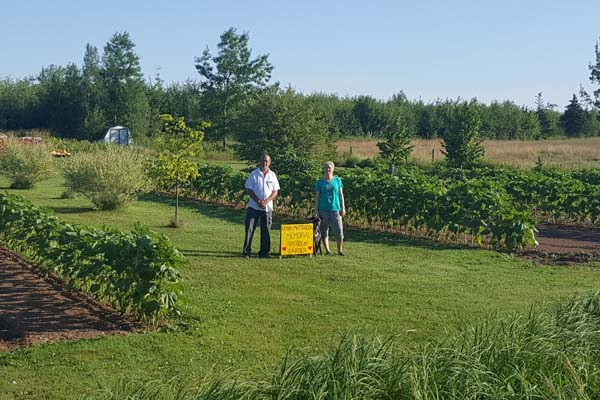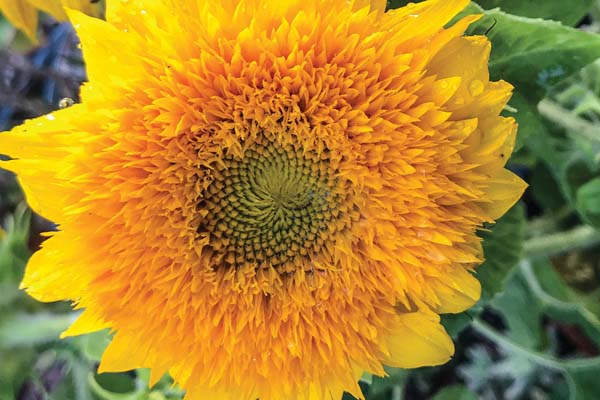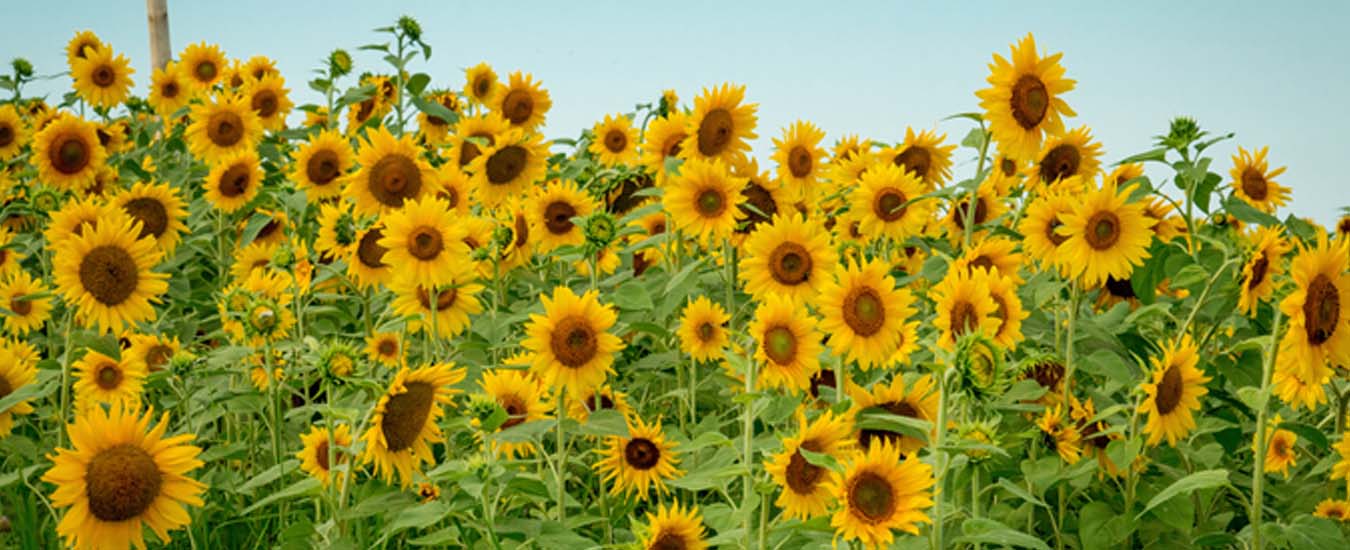Grow a few (dozen) sunflowers. You’ll be glad you did
One of my most cherished memories is of my late spouse making up stories and poems about a giant sunflower that arbitrarily sprouted (likely from bird seed) and grew just outside our kitchen window when we first moved to our former home. He was fascinated how it turned its face to follow the sun through the course of the day, and from that summer forward we always had sunflowers in our gardens, a practice I continue to this day.
The National Garden Bureau in the United States has designated 2021 as the Year of the Sunflower, which is terrific to encourage more people to plant these cheery delights. Some of us would argue that every year is the year of the sunflower, as our gardens aren’t complete without a few (or a few dozen, or a few hundred) plants smiling at us.
Botanical wonders
Before we get into the many charms of growing these plants, here’s a little sunflower botany for you: there are both annual and perennial sunflowers, and, some would argue, weedy forms as well. They are part of one of the two largest botanical families, the Asteraceae (aka Compositae), which includes (as the name suggests), asters, daisies, chicory, coneflowers, dandelions and many other familiar species. Native to North and South America, sunflowers were first grown as a crop in central America and were introduced to Europe and Eurasia in the 16th century.
What we consider a flower is actually made up of thousands of tiny individual flowers, called florets. The sterile outer flowers resemble petals and are called ray florets, while the florets in the centre are disc flowers, and will mature into seeds.
For those who are fascinated by oddities in nature, the florets in the centre of the sunflower head grow in interconnecting spirals of Fibonacci sequences of numbers, not in circles as you might think at first glance. This is a common occurrence in plant growth, including in evergreen cones, pineapples and artichokes, succulents, and flowers with a composite flower head. Without getting too much into that discussion, suffice it to say I would have done much, much better in math and algebra (maybe even calculus) if someone had brought plants into the discussion!
The sunflower’s botanical genus name Helianthus is derived from the Greek words for sun (helios) and flower (anthus). One of the fascinating aspects of these plants is how they exhibit heliotropism: their flower heads follow the sun as it crosses the sky, as used to fascinate my late spouse.

Dwayne and Sara Jewell Mattinson (here with Abby the dog) plant up to 400 sunflowers each year, in memory of Dwayne’s late father Donn, who used to plant them as well.
“Because it makes people happy”
Sara Jewell Mattinson writes for Saltscapes on a regular basis from her home in Port Howe, not far from Oxford, NS. People in that area regularly stop near her house, which faces onto a main route, because she and her husband Dwayne Mattinson have a big garden of large sunflowers. Sara explains how they’ve been doing this for the past eight years. “Dwayne’s father Donn liked sunflowers, so in 2013 Dwayne planted a row of them at the edge of the gardens in the back yard.” Dwayne chimes in, “My dad used to plant tall ones around his flagpole, and when he had to stop doing that, I just started to plant them in my gardens. He’d drive in and look at them.”
In 2015, the sunflower plot moved to a former strawberry patch where they currently grow each year, facing the road. The next year, Dwayne expanded the plot further to be two plots of three rows each. Sara chuckles, “I’m the one who weeds them!” They now plant between 300-400 seeds of large sunflowers that they buy at the Co-op store in Amherst; they don’t save seeds, leaving them for the birds, and purchase fresh seeds each year to ensure the best plants.
In 2020, Donn Mattinson passed away, so the sunflower garden became his memorial garden. Sara says, “Last year, I told people it was okay to drive in and wander around and take pictures. When you’re coming up the road towards Oxford, the sunflowers are visible as soon as you come around the corner half a kilometre away.”
She adds, “This isn’t a business venture—we do it because it makes people happy. All through June and July people stop Dwayne in town and tell him how well his plants are growing!” On her Facebook author page, she did “Sunflower Sunday” last year, alternating photos each week between the sunflowers growing around her chicken coop and Dwayne’s big patch. “It was one way to pass the first pandemic summer!” She plans to paint a “Year of the Sunflower” sign for the garden, and the memorial garden sign will go up again, too.
Young green thumbs
One of the many delightful attributes of sunflowers is that they are an ideal way to introduce children to the joys of gardening. The seeds are large enough for small fingers to easily handle, and kids can either grow a small variety ideal for raising in containers like Teddy Bear or Pacino, or they can start a big variety like Strawberry Blonde or Russian Mammoth indoors, transplant it outside when it’s warm enough, and watch to see how tall it can get.
Kids in a school classroom can have a friendly competition to grow the tallest sunflower in their class, providing of course there’s a spot to plant these happy flowers outside. They can even grow a “sunflower fort” at home, planting a number of a tall variety’s seeds in a square or rectangle to create a leafy hideaway for themselves.
You just never know what will kickstart a child’s interesting in gardening—whether for flowers or foods-—but encouraging kids to develop a green thumb will never steer them wrong!

A double form of sunflower, which doesn’t have as showy a centre as many varieties, but is still showy and eyecatching.
Planting recommendations
Because sunflowers are annual, you have to wait until the soil is warmed up and the risk of frost is past before planting them, usually in early June, unless you’re starting some inside to transplant out into containers or garden borders—then you can start them a couple weeks earlier.
Plant your seeds or transplants where they will get lots of sunlight—a minimum of 6-8 hours a day—in a site with well-drained, compost-rich soil. These plants produce taproots, so they need room to stretch those roots well down into the soil. If you’re preparing a dedicated seed bed for them, you can dig or till it up to a depth of several feet, but you only plant the seeds about one to one and a half inches down. Depending on whether you’re growing dwarf varieties, midsize or giant, space your seeds between six and 24 inches apart, or thin the seedlings out once they’re up and growing well.
If your location is susceptible to a lot of wind, you will possibly want to plant them against a wall or a fence, or consider putting up some sort of support system, especially for taller varieties—although they have strong stems, sunflowers can be blown down by a gale of wind like those we often get in late summer. You may also wish to cover the seeds with a row cover or netting to prevent birds from digging around and snacking on those seeds.
Be prepared to feed your sunflower plants with a good dry fertilizer and compost, as they are heavy feeders. Dwayne Mattinson gives his young plants a top dressing of fertilizer when they’re about a foot tall to ensure they develop strong stems and will flower well. While we often get adequate rainfall to keep growing sunflowers happy, you may need to supplement with the hose—remember to water well, not often, soaking the soil deeply then allowing it to almost dry out before watering again.
Not all sunflowers produce seed for snacking or saving for the birds, and those that do often need to have their heads covered to protect them from overly-keen feathered friends until you’re ready to harvest them. Like Sara and Dwayne, I don’t bother saving seed, preferring to let the birds enjoy them, and buying fresh seed each year. And practically speaking, many hybrid varieties are either sterile or won’t come true from seed. So, fresh is best!
A bouquet of varieties
What you plant for sunflower varieties depends on your purpose—there are the giant plants that can tower nine feet or more in height, and delightful small plants that fit nicely into a container for deck or walkway. Some have no pollen—making them a great choice for those who like to use them as cut flowers but don’t care for pollen everywhere—and some are multibranched, producing many flowers on each plant. These latter may be smaller than the massive heads of some, but they come in interesting colours, too.
What you find locally at nurseries and garden centres for sunflower seeds will vary, as there are many different companies offering varieties. It’s a bit late for mail order for this year, but here is a collection of varieties to check out now or next year.
Dwarf varieties
Teddy Bear; Irish Eyes; Little Becka; Pacino; Ms. Mars; Big Smile; Firecracker; Elf; Ring of Fire; Music Box
Tall varieties
Russian Mammoth; Earthwalker; Giant Sungold; Garnet Star; Strawberry Blonde; Autumn Beauty; Ruby Eclipse; Lemon Queen
Other colours
Orange Sun; Strawberry Blonde; Chiante; Moulin Rouge; Prado Red Shades; Solar Flare; Ring of Fire; Garnet Star
